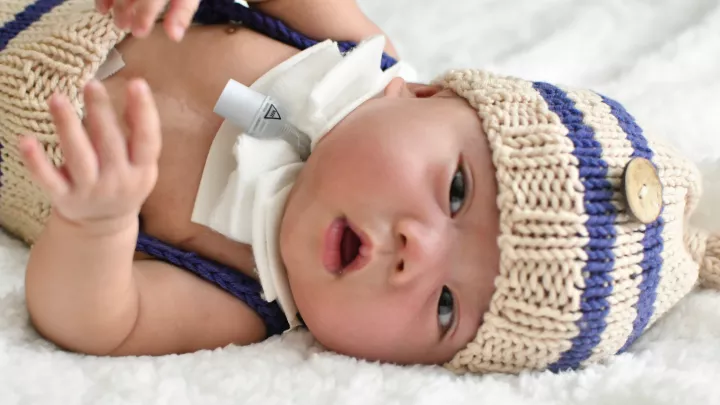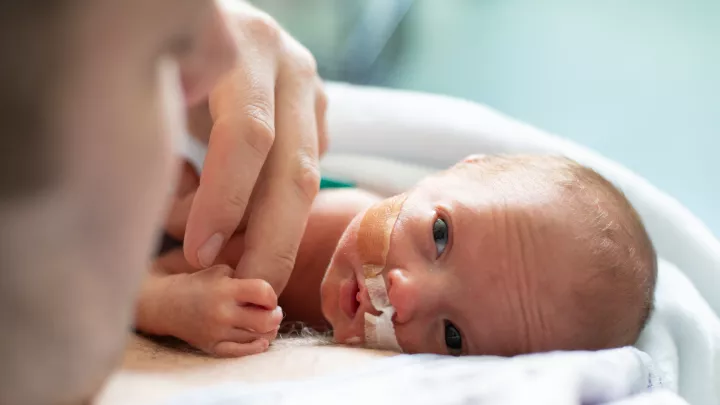
Twins Rory and Cooper (right)
Team of BPD Specialists Takes On Preemie’s Chronic Lung Disease
After lengthy stays at two other neonatal intensive care units (NICUs) could not resolve their infant son’s struggle with bronchopulmonary dysplasia (BPD), Brandon and Jo brought 4-month-old Cooper to Children’s Hospital Los Angeles, their expectations nearly faded out.
“Things were in a really bleak place,” Jo says.
Cooper’s case of BPD was severe. A form of chronic lung disease, BPD is a product of a premature birth; Cooper was a micro-preemie, born at 24 weeks, weighing hardly more than a pound, and his lungs were too small to carry out the task of breathing.
His twin brother, Rory, also suffered from the effects of prematurity, but not as harshly, and he was able to go home while Cooper stayed in the hospital for treatment.
Accelerating his decline, Cooper came down with rhinovirus, an infection that causes the common cold, but in his vulnerable condition led to a string of lung disorders—pneumonia, pulmonary hypertension, and respiratory failure. Doctors gave Brandon and Jo a chilling instruction.
“We were told to keep our phones on overnight in case we needed to come in and say goodbye,” Jo says.
The only recourse left was to put Cooper on extracorporeal membrane oxygenation, or ECMO, a life-support machine that takes over the work of his lungs, allowing them time to heal and grow. Jo says that a doctor pulled her and Brandon aside.
“He said, ‘If you are going to put your child on ECMO, you want to be at Children's Hospital Los Angeles. Children's is the expert at it.’”
A change in strategy starts the recovery
Once they got to the Stephen & Alexandra Cohen Foundation Newborn and Infant Critical Care Unit (NICCU) in March 2024, the family’s experience, as well as Cooper’s prospects, changed dramatically.
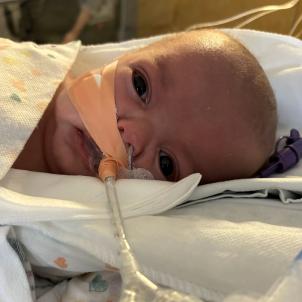
“It was night and day,” Brandon says.
Previously, he and his wife would have to urgently flag down a nurse for help if Cooper’s oxygen levels began to fall. “When we got to Children's, when he would desaturate like that, every doctor on the floor was in the room within a minute. We never had to notify them. The level of attention and detail and care was so much beyond what we had received.”
Although Cooper’s parents had consented to placing him on ECMO, the expertise of CHLA’s bronchopulmonary dysplasia team helped to avert it. “They had the ECMO machine ready to go for him, but we never had to do it,” Jo says.
Rachel Chapman, MD, Associate Division Chief of Neonatology, explains that the BPD Clinic, a component of the hospital’s Infant Chronic Lung Disease Program, cuts across multiple specialties to include the expertise of neonatologists, pulmonologists, gastroenterologists, respiratory therapists, nurses, and others, all dedicated to caring for infants with the disorder.
Their experience made the difference in getting Cooper stabilized. He was having ongoing issues with mucus plugging his airways and air getting trapped in his lungs, obstructing his breathing and leading to frequent episodes of desaturation—a decreased level of oxygen in the blood. Dr. Chapman says trying a different ventilator approach that was more aligned with Cooper’s particular disease got him turned around.
“We've learned over the past 10 to 15 years that there are strategies for trying to match the way we ventilate patients to the actual physiology of the patient,” she says.
Cooper’s breathing improved, and soon the rhinovirus began to run its course. The improvement in his condition allowed Dr. Chapman to withdraw the use of the muscle relaxant that was keeping Cooper asleep and immobilized so he would not wriggle around and fight his treatment.
“I have a video of him first opening his eyes again on March 24,” Brandon says.
That was 12 days after arriving at CHLA. Once Cooper was awakened, his recovery from BPD could begin in earnest as he could start receiving therapies, optimizing his nutrition, and weaning off medication and respiratory support.
“At that point,” Jo says, “the hope returned to us that maybe there was a way out of this.”
Maintaining a lung-friendly lifestyle
Cooper was discharged and sent home July 28, 2024, after more than eight months spent in intensive care, the last half at CHLA. His respiratory issues had abated enough to allow him to move off the ventilator and to start receiving oxygen through a tube resting beneath his nose.
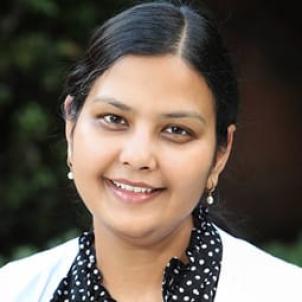
Nearing 18 months old, he is likely to remain on oxygen for the next few months to a year until his lungs are strong enough to support him on their own, all the while continuing to be looked after by pulmonologist Manvi Bansal, MD, co-Director of the Infant Chronic Lung Disease Program and Director of the BPD Clinic.
Dr. Bansal says that Cooper’s recovery is taking the typical course for a preemie with chronic lung disease. It’s just a matter of time—for most BPD patients, that generally means they’ll come off oxygen between 1 ½ and 3 years old.
She says a recent sleep study showed that Cooper’s breathing was much improved, but still somewhat fragile and not ready yet to be without oxygen support. “This isn’t pneumonia, which is fixed in 20 days,” Dr. Bansal says. “Your lungs just have to grow. Only then can you get better and get off oxygen.”
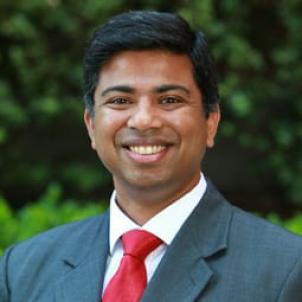
Narayan Iyer, MD, a neonatologist on the BPD team who has focused a portion of his research on both children and adults with the disease, says Cooper’s lungs have plenty of time to catch up, as lung development continues until age 25. The health of the physical environment he is raised in will influence how things go.
“There are many years’ worth of lung growth in front of these kids—that's a source of enormous hope,” Dr. Iyer says, “but also a reason we tell parents when they take their babies home to avoid environmental toxins such as secondhand smoke and pollution. And then there are things you want to promote, such as making the outdoors a part of their lives.
“Research has shown that when kids do more exercise, they end up having better lung outcomes than kids who have a more sedentary life. There's a lot of runway for their lungs to grow and be as normal as possible.”
Making progress toward a new normal
A second major consequence of his early birth, Cooper suffers from retinopathy of prematurity, an eye disorder that has impaired his vision in his right eye. He’s had three eye surgeries as a result and continues to see CHLA ophthalmologist Aaron Nagiel, MD.
“I don't think he's ever going to be a sharpshooter, but he can see,” Brandon says.
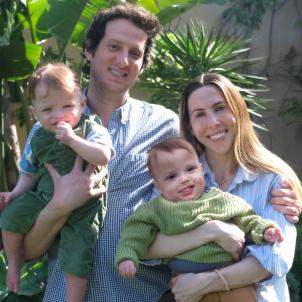
There are longer-term risks connected to being a preemie, such as the potential for developmental delay, but a brain MRI that checked for cognitive deficits found none.
Jo and Brandon aren’t quite ready to release the fear that became entrenched in their lives, but it doesn’t prevent them from seeing and celebrating Cooper’s progress.
“The 260 days we spent in the NICU with him does teach you to always be a little bit guarded,” Jo says. “He still is delayed, but every day he surprises us. Every day he grows by leaps and bounds.
“We know he's at risk for different things, like autism and learning disabilities, more so than a full-term baby, but I think that he's going to have a full life. I do feel we have found a new normal, and there's so much happiness in that.”

